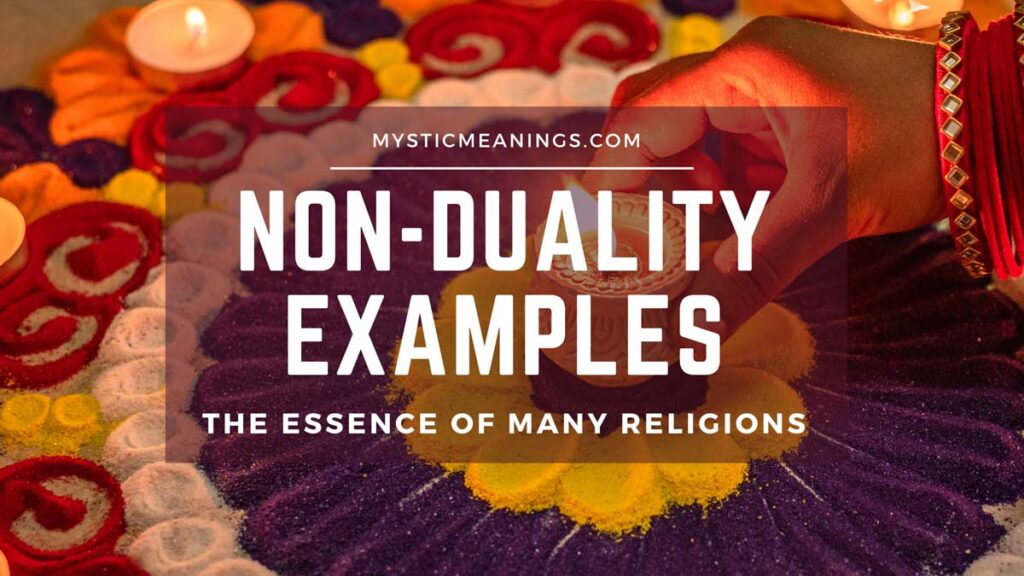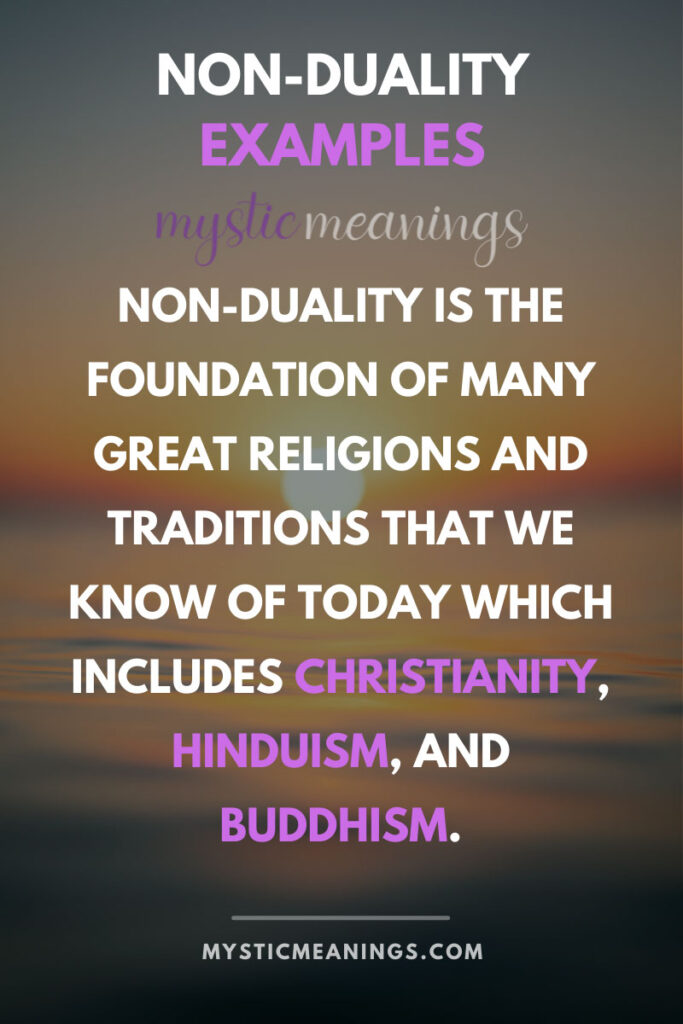In a pursuit to understand non-duality better, we may need to explore some non-duality examples found in various cultures and religions.
Being a concept that liberates us from our ego and helps us understand the truth of reality, non-duality has a significant association with various religions in the world including the divinity of Jesus in Christianity, the poetry of Rumi in Sufism, Atman with Brahman in Hinduism, and more.
The traditional philosophies related to non-duality highlight that this concept is the basis of pure awareness. As awareness is the foundation of human experience, it helps us to discover the absolute truth underlying our realization about ourselves, the world, and beyond.
So, let’s explore some non-duality examples.

What is Non-Duality?
The term “non-duality” is a derivative of the Sanskrit word, “Advaita.” The literal meaning of the word Advaita is “A,” “Dvaita,” or “Not,” “Two.” The word Advaita, in a deeper sense, means a state of consciousness where we can identify the self or Atman with Brahman or the present reality. Also, with this greater consciousness, we can catch the sight of reality in and around us.
In non-duality, we can call the pure consciousness or the absolute truth sacrosanct. Further, our consciousness becomes pure when we see things, decide and behave by getting rid of faulty judgments and mental compartmentalizations.
In other words, there is always a conflict in every living human being. We have our thoughts and perceptions formed by our previous experiences, and then there are things occurring in the present.
Non-duality ends this torment by emancipating us from the shackle of our thoughts. So, there are no preconceived notions, and we are only conscious of our current experience, which is absolute and one.
When our mind is free of the burden of thoughts, and we focus only on reality, our mind becomes open to wonders and possibilities. This openness of mind can further lead to the discovery of the ultimate enlightenment or truth. Also, in the absence of thoughts that contradict our present experience, there we can know pure bliss.

Christianity and Non-Duality Examples
The association of non-duality with Christianity can be found in various practices that can be clubbed together as “Christian Contemplation.” Christian Contemplation encourages the believers to become aware of the divine God. We can also interpret “Christian Contemplation” as a way to achieve greater awareness.
Once again, many non-duality examples can be found all throughout the Bible. In the New Testament, you will see that salvation, similar to the Hindu non-dual concept of “Moksha,” is depicted as the process of “becoming one.”
In verse John 17:11, Jesus is praying to the Holy Father for his disciples. He is asking the Holy Father to guard his believers in the power of his name and the name he gave to Jesus, as they are one.
In John 17:21, Jesus is praying that the Holy Father and Jesus both reside in each other. He is also making a pledge so that the believers can be united with him and the Holy Father. This verse further can be considered as the foundation of the “Doctrine of Deification.”
The “Doctrine of Deification” talks about a process to salvation where our soul becomes united with God. Here also, the human soul becomes one and absolute with God, referring to the core idea of non-duality. The reflection of the same concept can be found in Martin Luther’s teaching of salvation, where he says that God became men to help men become God.
You will find more non-duality examples in the preachings of Saint Gregory of Nyssa. Also, there are many verses in Peter, Ephesians, and Colossians referring to non-duality or oneness.
Most importantly, in Christian beliefs, Jesus Christ was a man and God at the same time, unifying the two into one.

Hinduism and Non-Duality Examples
Advaita Vedanta, or the 3000-years old Hindu school of philosophy and spirituality, establishes the connection between non-duality and Hinduism. One of the main preachings of Advaita Vedanta is the unification of Atman or self with Brahman or the ultimate reality. Brahman is one and absolute, and Brahman cannot be created, altered, or perished.
Adi Shankaracharacharya, the most respected preacher of Advaita Vedanta, said that many verses in the Upanishad, or Hindu Vedic text in Sanskrit, reflect on the union of Atman and Brahman. In Advaita Vedanta, four of those verses are considered “Mahabakyas.” The Mahavakyas referred to four verses in the Chandogya Upanishad, Brihadaranyaka Upanishad, Aitareya Upanishad, and Mandukya Upanishad.
The verse “Tat Tvam Asi” verse in Chandogya Upanishad means “that how you are.” It also means that the nature of existence is the essence of reality. Here, we can understand the concept of Advaita Vedanta, which tells us that reality is how we see it. Overall, Brahman is one and absolute, and different perceptions do not impact its sanctity.
The “Aham Brahman Asmi” verse in Brihadaranyaka Upanishad prominently highlights the identification of self or Atman with the ultimate reality, or Brahman.
The “Prajnanam Brahman” verse in the Aitareya Upanishad says that the absolute reality or “Brahman” is founded by our consciousness or “Prajna.”
The “Ayam Atma Brahma” verse in the Mandukya Upanishad tells us that “Atman” or self is the “Brahman” or the absolute reality. So, here Atman and Brahman are not two different entities. They are synonymous and one.
Unearthing non-duality examples in Hinduism can be a vast and enlightening process with endless scriptures associated with its spiritual and philosophical aspects. We need an in-depth understanding of Advaita Vedanta and the Upanishad to find and understand abundant non-duality examples in Hinduism.
Islam and Non-Duality Examples
Sufism or Islamic Mysticism is deeply associated with non-duality. As resonated in non-duality, Sufism harps that timeless or greater awareness is the foundation of the existence of everything. Sufism asks us to look for God inside us, unifying the worshipper with the worshipped.
Non-duality teaches us to keep our minds open and adaptive to possibilities by emancipating our minds from the burden of preconceived notions. Similarly, spontaneity and being free of any predetermination lie at the heart of Sufism.
Once again, as non-duality frees us from our world of thoughts, judgments, and mental compartmentalization, Sufism prevents crystallization of set beliefs or thoughts.
Non-duality also teaches us to accept the happenings in the world with wonder, and gratitude, and then combine all the experiences into a whole. Similarly, Sufism is about inclusion and adaptability.
Rumi, the Islamic scholar, writes in one of his Sufi poems that he can feel the presence of his “Divine Friend” in his heart. He further writes that an awakened or enlightened heart is like a lamp. And we can infer this in the line of non-duality, as only an awakened heart can be the light to discover the ultimate truth.
Again, we can refer to one of the “Duas” or prayers of Prophet Muhammad, the founder of Islam. He asks God to show him the reality of things.
Isn’t the quest for the ultimate or absolute or one reality the heart of non-dualism?

Buddhism and Non-Duality Examples
Various Buddhist views in Indian Buddhism, Madhyamaka, Yogacara, and Tantric Buddhism correspond to non-duality. Non-duality can be directly associated with “Advaya,” which means “Not Two.”
Lord Buddha did not use the term “Advaya” in his early preachings. However, he imparted knowledge on the union of “Samadhi,” or the synthesized states of mental focus, with “Dhyana,” or meditative absorption. This concept aligns with the concept of non-duality in the Upanishad.
Vimalakirti Nirdesha and some other Sutras in Buddhist Mahayana texts used the term “Advaya.” Vimalakirti Nirdesha Sutra teaches that we need to acknowledge and respect the contradictions. These contradictions or extremes are not separate from each other, and they lead us to the ultimate awareness, which is one and absolute.
The presence of non-duality can also be found in another Mahayana School called Madhyamaka. Indian Philosopher Nagarjuna was its founder.
The Mulamadhyamakakarika is the core text of this Buddhist school of beliefs. Nagarjuna writes in the Mulamadhyamakakarika that Nirvana, or the ultimate liberation, is not separate from “Samsara” or the life in the material world. There is hardly any difference between the two, and hence they are whole or one.
The Mahayana-sutra-alamkara-karika is a significant account of the Yogacara Buddhist view. This text also highlights that Nirvana and Samsara are not different, and in the supremely awakened state, or Buddhahood, the operation is “Advaiya Vritti,” or non-dual.
Tantric Buddhism also says that the ultimate aim is to achieve Buddhahood, or the non-dual state of ultimate awakening.
The evidence of non-dual practices and concepts can be found in East-Asian and Tibetan Buddhist views. In more recent times, Thich Nhat Hanh, the “father of mindfulness,” has preached that every one of us is a leaf of the one tree and a wave of the one sea, resonating with the concept of non-duality.
Summary of the Non-Dual Tradition
Non duality is a versatile concept with many definitions and interpretations. However, at the core of it, lies the concept of knowing the self to achieve a higher state of consciousness where you can identify with the ultimate reality.
Along with Christianity, Hinduism, Buddhism, and Islam, the concept of Non-duality is also associated with Taoism. Judaism, Sikhism, etc. As you explore more religious views and beliefs, you will find how non-duality is planted in almost every culture or civilization.
For help to seek greater awareness, Parisa Living captures the essence of discovering your true self in a beautiful platform that incorporates monthly themes, meditations, journal prompts, live video and more.
Enjoy an exclusive 2-week free trial here.

